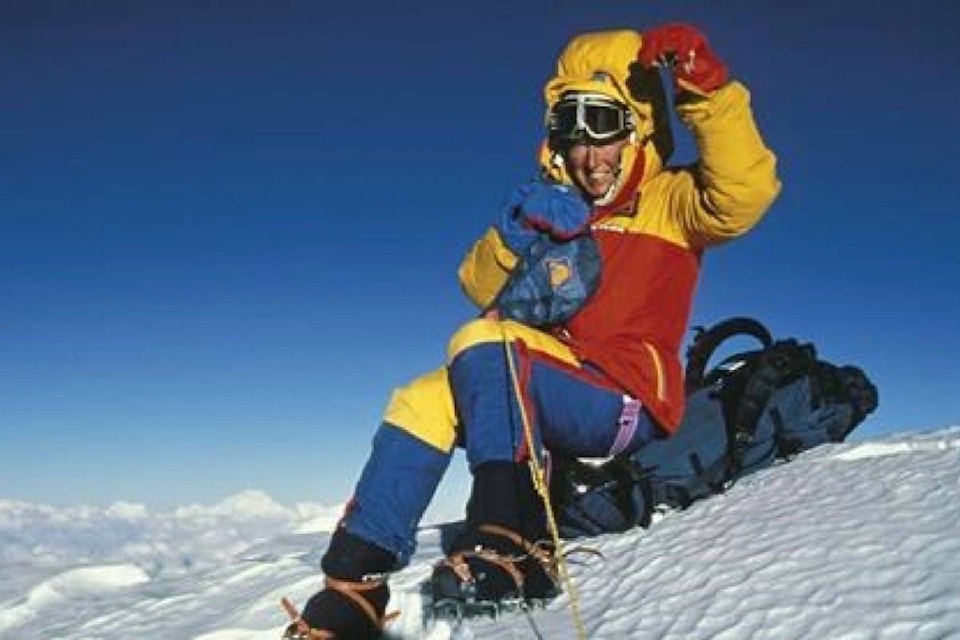CANMORE, Alta. — More than three decades after becoming the first woman from the Americas to summit Mount Everest, Sharon Wood looks back with pride about how she reached the top rather than how she made history.
The 62-year-old resident of Canmore, Alta., has grappled with her success since she and climbing partner, Dwayne Congdon, reached the 8,848-metre summit in 1986. The climb also made her the first woman in the world to reach the summit via the West Ridge from Tibet and without Sherpa support.
Wood has put her experience into words in a book released this month titled “Rising: Becoming the First North American Woman on Everest.”
The book — part mountain adventure, part memoir — has made the long list for the 2019 Banff Mountain Book Competition.
Sitting in her backyard in mid-August, Wood talked about why she finally decided to write it.
“Everest has not gone away,” she said. “It’s every day. Not a day goes by without Everest somehow — whether someone recognizes me on the street or asks me to come to their school or asks me to make a presentation.”
The world’s highest peak, she said, has also seen a new era of adventure tourism in the last 20 years.
Nepal issued a record 381 permits this year, which led to climbing jams that likely contributed to the greatest fatality toll in four years. Eleven people died.
“The more I see, the more I realize what we did then. And the spirit in which we did it and the style in which we climbed the mountain is something I am incredibly proud of,” said Wood. “There is something being lost.
“I hope that I can make a little dent in perhaps changing the direction of this all-about-me, commercialized phase of adventure.”
In the book, Wood said it was important for her to show how their Canadian team climbed Everest rather than the outcome.
“It’s trophy hunting now whereas style used to matter,” she said. “The element of good style was a really good efficient team who communicated well with one another and (had) some selflessness.”
A Nepal government committee recently recommended that would-be Everest climbers be required to have scaled other tall peaks, to have been trained properly and to possess certificates of good health and insurance that would cover rescue costs.
When Wood climbed Everest, there were fewer permits being issued.
“The mountain was reserved for the elite … and they had to have their act together,” she said. “They were national expeditions up until that point. Now you can be an individual.”
She said she’s surprised by the insatiable demand to climb the mountain and referred to a photo that went viral this year showing a lineup of climbers at the summit.
“Seeing all those people to me speaks to something that’s fundamentally wrong in our culture, in our society,” said Wood. “People are doing that for the trophy and the selfie.
“There’s so much more.”
Wood and most of her 12 teammates, which also included well-known mountaineers Barry Blanchard, Laurie Skreslet and Albi Sole, were aiming for the top when they arrived at Everest base camp in 1986. There was some pressure for her to reach the summit first, because a woman on the U.S. team was making the attempt at the same time, but Wood said that was never her focus.
She explains in the book that the climb didn’t quite go as originally planned.
Blanchard was initially teamed up with Congdon to make the first summit bid, while Wood and Sole were to go second — until the summit leader suggested she go up with Congdon. They ended up being the only two from the team who made it to the top that year.
“In the end, with all the shuffling and all the factors, that’s how it worked out,” she said.
Sole, who read an early draft of Wood’s book, said he expects they all have different memories of the trip.
“It was definitely a big event in my life,” he said. “But for her … it’s kind of like this bossy sister that’s always there with her. It’s saying, ‘Here I am. I’m Everest. I’m Everest. I’m Everest.’”
Sole, executive director of the Outdoor Council of Canada, said he likes that Wood’s book looks at who she is now rather than who she was then.
“That’s a really fresh way of looking at a big event like that,” he said. “This is a much more interesting and nuanced account about how being involved in something like that can change your life.”
